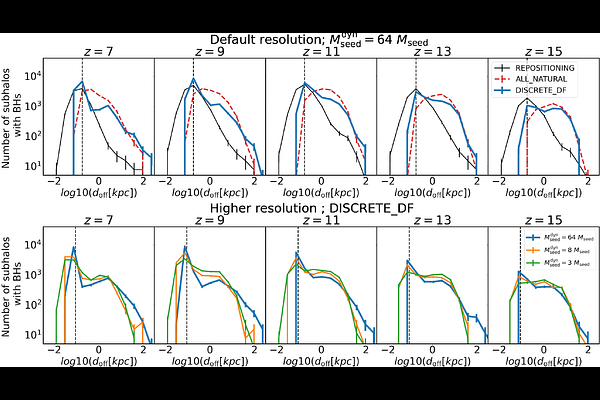Dynamics of low-mass black hole seeds in the BRAHMA simulations using subgrid-dynamical friction: Impact on merger-driven black hole growth in the high redshift Universe

Dynamics of low-mass black hole seeds in the BRAHMA simulations using subgrid-dynamical friction: Impact on merger-driven black hole growth in the high redshift Universe
Aklant K. Bhowmick, Laura Blecha, Luke Z. Kelley, Aneesh Sivasankaran, Paul Torrey, Rainer Weinberger, Nianyi Chen, Mark Vogelsberger, Lars Hernquist, Priyamvada Natarajan
AbstractWe analyze the dynamics of low-mass black hole (BH) seeds in the high-redshift ($z\gtrsim5$) Universe using a suite of $[4.5~\mathrm{Mpc}]^3$ and $[9~\mathrm{Mpc}]^3$ BRAHMA cosmological hydrodynamic simulations. The simulations form seeds with mass $M_{\mathrm{seed}}=2.2\times10^3~M_{\odot}$ in halos that exceed critical thresholds of dense & metal-poor gas mass ($5-150~M_{\mathrm{seed}}$) and the halo mass ($1000-10000~M_{\mathrm{seed}}$). While the initial BRAHMA boxes pinned the BHs to the halo centers, here we implement a sub-grid dynamical friction (DF) model. We also compare simulations where the BH is allowed to wander without the added DF. We investigate the spatial and velocity offsets of BHs in their host subhalos, as well as BH merger rates. We find that subgrid DF is crucial to ensure that a significant fraction of BHs effectively sink to halo centers by $z\sim5$, thereby enabling them to get gravitationally bound and merge with other BHs at separations close to the spatial resolution ($\sim0.2-0.4~\rm kpc$) of the simulation. For the BHs that merge, the associated merger time scales lag between $\sim100-1000~\mathrm{Myr}$ after their host halos merge. Compared to predictions using BH repositioning, the overall $z\gtrsim5$ BH merger rates under subgrid DF decrease by a factor of $\sim4-10$. Under subgrid DF, the different seed models predict merger rates between $\sim100-1000$ events per year at $z\gtrsim5$. These mergers dominate early BH growth, assembling BHs up to $\sim10^4-10^5~M_{\odot}$ by $z\sim5$, wherein $\lesssim2~\%$ of their mass is assembled via gas accretion. Our results highlight the promise for constraining seeding mechanisms using gravitational waves from future facilities such as the Laser Interferometer Space Antenna.